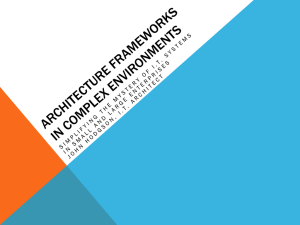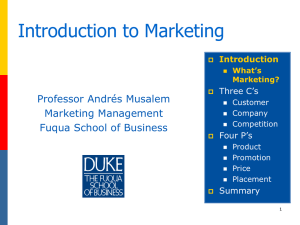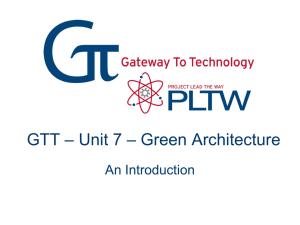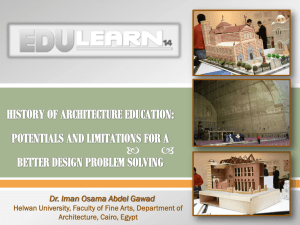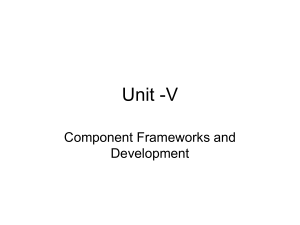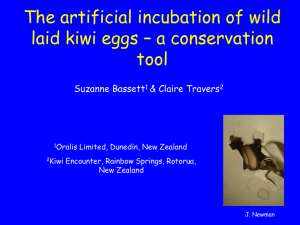e-services ToT module6
advertisement
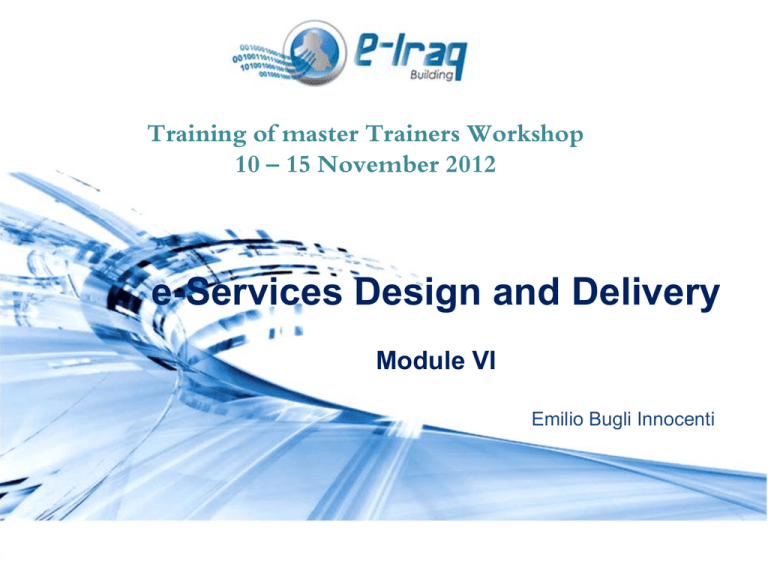
Training of master Trainers Workshop 10 – 15 November 2012 e-Services Design and Delivery Module VI Emilio Bugli Innocenti e-Services Design & Delivery Contents of Module VI – “e-Services Design & Delivery” The Enterprise Architecture Enterprise Architectural Frameworks Examples / Case Study: RM-ODP in the KIWI Project e- Service Design & Delivery: the Technical Perspective ENTERPRISE ARCHITECTURE identifies the main components of the organization, its information systems, the ways in which these components work together in order to achieve defined business objectives, and the way in which the information systems support the business processes of the organization components include staff, business processes, technology, information, financial and other resources, etc. e- Service Design & Delivery: the Technical Perspective ENTERPRISE ARCHITECTURE Enterprise architecting is the set of processes, tools, and structures necessary to implement an enterprise-wide coherent and consistent IT architecture for supporting the enterprise's business operations It takes a holistic view of the enterprise's IT resources rather than an application-by-application view e- Service Design & Delivery: the Technical Perspective ENTERPRISE ARCHITECTURE The design of business and IT system alignment is the domain of Enterprise Architecture (EA). Enterprise architects seek to align enterprise processes and structure with their supporting IT systems.” (Wegmann et al. 2005) Enterprise Architecture is the process of translating business vision and strategy into effective enterprise change by creating, communicating and improving the key principles and models that describe the enterprise’s future state and enable its evolution” (Gartner Group 2006) e- Service Design & Delivery: the Technical Perspective ENTERPRISE ARCHITECTURE The Open Group's Enterprise Architecture definition (TOGAF 2003): There are four types of architecture that are commonly accepted as subsets of an overall Enterprise Architecture: business architecture: this defines the business strategy, governance, organisation, and key business processes data/information architecture: this describes the structure of an organization's logical and physical data assets and data management resources. application (systems) architecture: this kind of architecture provides a blueprint for the individual application systems to be deployed, their interactions, and their relationships to the core business processes of the organization. Information Technology (IT) architecture: the software infrastructure intended to support the deployment of core, mission-critical applications e- Service Design & Delivery: the Technical Perspective ENTERPRISE ARCHITECTURAL FRAMEWORKS An enterprise architecture framework (EA framework) is an architecture framework which defines how to organize the structure and views associated with an enterprise architecture “views” are typical elements which provide the mechanisms for communicating information about the relationships that are important in the architecture Enterprise Architectural Frameworks Enterprise Architectural Frameworks ENTERPRISE ARCHITECTURAL FRAMEWORKS Enterprise Architectural Frameworks CASE STUDY RM-ODP FRAMEWORK used in the context of e-Governance RM-ODP – Reference Model – Open Distributed Processing • ISO/IEC/ITU Standard • Viewpoint modeling • focuses mainly on Business process, Technical Functionality and Solution • BPMN as business modeling • UML as system modeling Enterprise Architectural Frameworks CASE STUDY -RM-ODP FRAMEWORK e-Governance Viewpoint Modeling • • • • • The enterprise viewpoint, which focuses on the purpose, scope and policies for the system. It describes the business requirements and how to meet them. The information viewpoint, which focuses on the semantics of the information and the information processing performed. It describes the information managed by the system and the structure and content type of the supporting data. The computational viewpoint, which enables distribution through functional decomposition on the system into objects which interact at interfaces. It describes the functionality provided by the system and its functional decomposition. The engineering viewpoint, which focuses on the mechanisms and functions required to support distributed interactions between objects in the system. It describes the distribution of processing performed by the system to manage the information and provide the functionality. The technology viewpoint, which focuses on the choice of technology of the system. It describes the technologies chosen to provide the processing, functionality and presentation of information. Enterprise Architectural Frameworks CASE STUDY -RM-ODP FRAMEWORK used in the context of eGovernance The EU KIWI Project (A Knowledge Management System for Civil Servants) Enterprise Viewpoint • It was considered so important that became a project deliverable per se • It gathers user requirements • It describes the knowledge process inside the target administrations in Italy, France and Finland • It identifies the “AS-IS” and the “TO-BE” processes fro each administration • Information collected according to: – – – – – Basic Information / Analysis of the internal organisation Knowledge Management Technical Aspects Performance evaluation Swot analysis Enterprise Architectural Frameworks CASE STUDY -RM-ODP FRAMEWORK used in the context of eGovernance The EU KIWI Project (A Knowledge Management System for Civil Servants) Enterprise Viewpoint Ministry of Interior Italy Enterprise Architectural Frameworks CASE STUDY -RM-ODP FRAMEWORK used in the context of eGovernance The EU KIWI Project (A Knowledge Management System for Civil Servants) Enterprise Viewpoint Prefecture of Milan Italy Enterprise Architectural Frameworks CASE STUDY -RM-ODP FRAMEWORK used in the context of eGovernance The EU KIWI Project (A Knowledge Management System for Civil Servants) Enterprise Viewpoint Prefecture of Milan Italy Focus on the Immigrants Regularisation Process Enterprise Architectural Frameworks CASE STUDY -RM-ODP FRAMEWORK used in the context of eGovernance The EU KIWI Project (A Knowledge Management System for Civil Servants) Enterprise Viewpoint Objectives of the new process INTERVENTIONS / INSTRUMENTS OBJECTIVES Standardisation intervention Common procedures and rules Electronic databases Usage of mobile devices Increase efficiency of Knowledge Management Increase effectiveness and usefulness of KM Favour knowledge sharing among sectors Increase uniformity among bodies Facilitate the organisation of courses Enterprise Architectural Frameworks CASE STUDY -RM-ODP FRAMEWORK used in the context of eGovernance • The EU KIWI Project (A Knowledge Management System for Civil Servants) Information Viewpoint Two main information content types are considered: • The Knowledge content data and metadata: it is the exchangeable information, it is managed by the knowledge information system; • The Configuration content data and metadata: it is the system configuration information, for example the mobile device characteristics or the wireless channel characteristics. The Knowledge content information is split up into two main categories: • The Information resource data: metadata about useful resources, such as: websites, multimedia documents stored in databases, other information systems, etc.; • The Knowledge data and metadata: the codified knowledge contained in the managed basic data or in the users' tacit knowledge. Codified taxonomies and ontologies are examples of knowledge data, the metadata is useful to link such encoded knowledge to the basic data. Enterprise Architectural Frameworks CASE STUDY -The EU KIWI Project (A Knowledge Management System for Civil Servants) Computational Viewpoint Enterprise Architectural Frameworks CASE STUDY -The EU KIWI Project (A Knowledge Management System for Civil Servants) Engineering Viewpoint Enterprise Architectural Frameworks CASE STUDY -The EU KIWI Project (A Knowledge Management System for Civil Servants) Technology Viewpoint The technology environment heterogeneity is handled resorting to the following approach: • As far as the developed modules, open de-facto standard solutions, coming out from standardisation bodies and industry consortia, are utilized; • As far as external modules integration, Web-services interoperability technology is used. The following technology framework has been analysed: Network architectures GPRS (General Packet Radio Service); UMTS (Universal Mobile Telecommunication Service); WLAN (Wireless Local Area Network) IEEE 802.11 family; Bluetooth technology (IEEE 802.15). Device Technologies Voice Centric devices Phone handset; All the GPRS compliant devices SmartPhone; Nokia 7650 Enterprise Architectural Frameworks CASE STUDY -The EU KIWI Project (A Knowledge Management System for Civil Servants) Technology Viewpoint Data centric Devices PDA (Personal Digital Assistant) Compaq iPAQ H3970 Delivery technology MMS (Multimedia Messaging Service) ; Streaming. E-Business Technologies Java technology; Microsoft .NET technology; XML technology; Web Services technology (UDDI, SOAP, WSDL, etc.);

